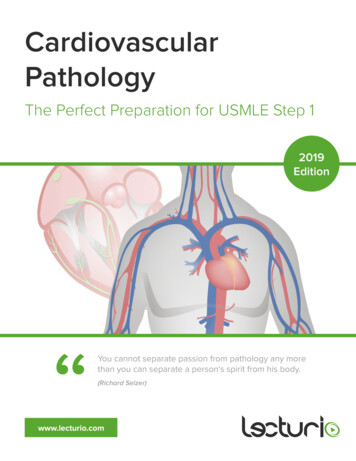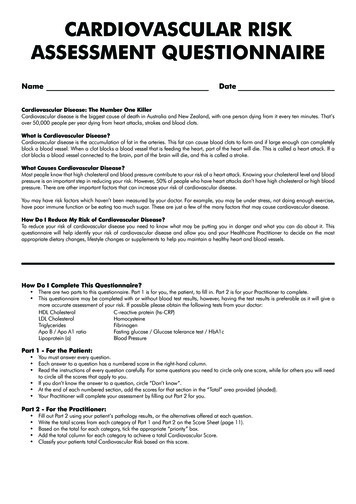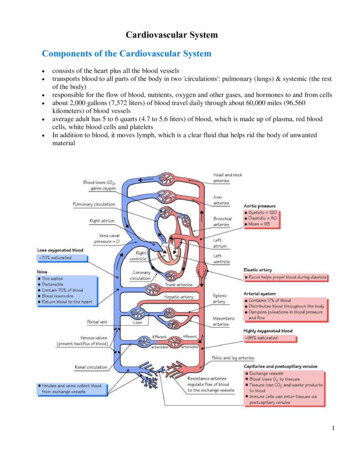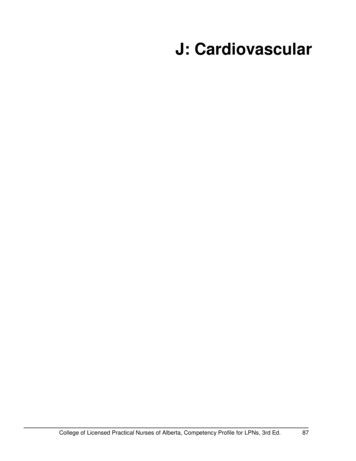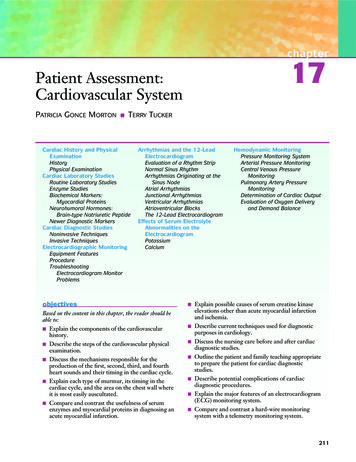
Transcription
chapter17Patient Assessment:Cardiovascular SystemPATRICIA GONCE MORTON TERRY TUCKERCardiac History and PhysicalExaminationHistoryPhysical ExaminationCardiac Laboratory StudiesRoutine Laboratory StudiesEnzyme StudiesBiochemical Markers:Myocardial ProteinsNeurohumoral Hormones:Brain-type Natriuretic PeptideNewer Diagnostic MarkersCardiac Diagnostic StudiesNoninvasive TechniquesInvasive TechniquesElectrocardiographic MonitoringEquipment FeaturesProcedureTroubleshootingElectrocardiogram MonitorProblemsArrhythmias and the 12-LeadElectrocardiogramEvaluation of a Rhythm StripNormal Sinus RhythmArrhythmias Originating at theSinus NodeAtrial ArrhythmiasJunctional ArrhythmiasVentricular ArrhythmiasAtrioventricular BlocksThe 12-Lead ElectrocardiogramEffects of Serum ElectrolyteAbnormalities on theElectrocardiogramPotassiumCalciumobjectives Explain possible causes of serum creatine kinaseelevations other than acute myocardial infarctionand ischemia.Explain the components of the cardiovascularhistory.Describe the steps of the cardiovascular physicalexamination.Discuss the mechanisms responsible for theproduction of the first, second, third, and fourthheart sounds and their timing in the cardiac cycle. Explain each type of murmur, its timing in thecardiac cycle, and the area on the chest wall whereit is most easily auscultated.Compare and contrast the usefulness of serumenzymes and myocardial proteins in diagnosing anacute myocardial infarction. Describe current techniques used for diagnosticpurposes in cardiology.Discuss the nursing care before and after cardiacdiagnostic studies.Outline the patient and family teaching appropriateto prepare the patient for cardiac diagnosticstudies.Describe potential complications of cardiacdiagnostic procedures.Explain the major features of an electrocardiogram(ECG) monitoring system.Compare and contrast a hard-wire monitoringsystem with a telemetry monitoring system.Based on the content in this chapter, the reader should beable to: Hemodynamic MonitoringPressure Monitoring SystemArterial Pressure MonitoringCentral Venous PressureMonitoringPulmonary Artery PressureMonitoringDetermination of Cardiac OutputEvaluation of Oxygen Deliveryand Demand Balance 211
212 PART IVCARDIOVASCULAR SYSTEMExplain correct electrode placement when monitoring the standard leads or the chest leads with athree-electrode and a five-electrode system.Discuss steps for troubleshooting ECG monitorproblems.Describe the components of the ECG tracing andtheir meaning.Explain the steps used to interpret a rhythm strip.Describe the causes, clinical significance, andmanagement for each of the arrhythmias discussed.Describe the parameters of a normal 12-lead ECG.Define electrical axis, and determine the directionof the axis for a 12-lead ECG.Explain the causes, clinical significance, and treatment for bundle branch blocks, atrial enlargement,and ventricular enlargement.Describe the ECG changes associated with serumpotassium and calcium abnormalities.The application of complex technology to the assessment and management of cardiovascular and cardiopulmonary conditions has increased greatly in thepast several decades. Use of advanced and complex technologies is an integral part of the care of critically ill patients.Nevertheless, the value of a comprehensive cardiovascularhistory and physical examination should never be underestimated. The chapter begins with a discussion of the cardiac history and physical examination and then discussestechnological assessment techniques.CARDIAC HISTORY ANDPHYSICAL EXAMINATIONThe cardiovascular history provides physiological and psychosocial information that guides the physical assessment,the selection of diagnostic tests, and the choice of treatment options. During the history, the nurse asks about thepresenting symptoms, past health history, current healthstatus, risk factors, family history, and social and personal history. The nurse also inquires about behaviorsthat promote or jeopardize cardiovascular health and usesthis information in guiding health teaching. During theprocess of taking a thorough history and performing a physical examination, the nurse has an opportunity to establishrapport with the patient and to evaluate the patient’s general emotional status.HistoryCHIEF COMPLAINT AND HISTORYOF PRESENT ILLNESSThe nurse begins the history by investigating the patient’schief complaint. The patient is asked to describe in his orher own words the problem or reason for seeking care. Analyze the characteristics of normal systemic arterial, right atrial, right ventricular, pulmonaryartery, and pulmonary artery wedge pressurewaveforms.Describe the system components required to monitor hemodynamic pressures.State nursing interventions that ensure accuracy ofpressure readings.Discuss the major complications that can occurwith an indwelling arterial line and pulmonaryartery catheter.Describe the thermodilution method of measuringcardiac output.Identify the determinants of cardiac output.Evaluate the factors influencing oxygen deliveryand consumption.Use Sv–O2 monitoring to assess oxygen delivery andconsumption.The nurse then asks for more information about the present illness, using the questions in Box 17-1. Answers tothese questions are essential to understanding the patient’sperception of the problem. The nurse also asks the patientabout any associated symptoms, including chest pain, dyspnea, edema of feet/ankles, palpitations and syncope,cough and hemoptysis, nocturia, cyanosis, and intermittent claudication.Chest PainChest pain is one of the most common symptoms ofpatients with cardiovascular disease. Therefore, it is anessential component of the assessment interview. Chestpain is often a disturbing or even frightening experiencefor a patient, so the patient may be hesitant to initiate adiscussion of chest pain. The questions listed in Box 17-1are particularly useful when assessing chest pain.Because cardiac pain (angina pectoris) is the result of animbalance between oxygen supply and oxygen demand, itusually develops over time. Typically, anginal pain does notstart at maximal intensity. Not all chest pain is cardiac inorigin, and careful reporting of the characteristics of thepain and the behaviors (or lack thereof) that precede theonset of pain is required. The nurse asks the patient abouthis or her normal baseline status before the symptoms developed. It is also important to ask about the onset of the symptoms to determine the date and time that the symptomsstarted and whether the onset was sudden or gradual.Chest pain caused by coronary artery disease is oftenprecipitated by physical or emotional exertion, a meal, orbeing out in the cold. Palliative measures to relieve anginalpain may include rest or sublingual nitrates; these measuresusually do not relieve the pain of a myocardial infarction(MI). The quality of cardiac chest pain is often described asa heaviness, tightness, squeezing, or choking sensation. If
CHAPTER 17box 17-1Assessment Parameters: Questions to Askin a Symptom AssessmentN Normal: Describe your normal baseline. What was itlike before this symptom developed?O Onset: When did the symptom start? What day?What time? Did it start suddenly or gradually?P Precipitating and palliative factors: What broughton the symptom? What seems to trigger it—factorssuch as stress, position change, or exertion? Whatwere you doing when you first noticed the symptom?What makes the symptom worse? What measureshave helped relieve the symptom? What have you triedso far? What measures did not relieve the symptom?Q Quality and quantity: How does it feel? How wouldyou describe it? How much are you experiencing now?Is it more or less than you experienced at any other time?R Region and radiation: Where does the symptomoccur? Can you show me? In the case of pain, does ittravel anywhere such as down your arm or in yourback?S Severity: On a scale of 1 to 10, with 10 being theworst ever experienced, rate your symptom. How badis the symptom at its worst? Does it force you to stopyour activity and sit down, lie down, or slow down? Isthe symptom getting better or worse, or stayingabout the same?T Time: How long does the symptom last? How oftendo you get the symptom? Does it occur in associationwith anything, such as before, during, or after meals?the pain is reported as superficial, knifelike, or throbbing,it is not likely to be anginal. Cardiac chest pain is usuallylocated in the substernal region and often radiates to theneck, left arm, the back, or jaw. Although the pain is oftenreferred to other areas, anginal pain is visceral in origin,and most complaints include a reference to a “deep, inside”pain. When the patient is asked to point to the painful area,the painful area is about the size of a hand or clenched fist.It is unusual for true anginal pain to be localized to an areasmaller than a fingertip. Using a scale of 1 to 10, with 10being the worst pain the patient has ever experienced, thepatient is asked to rate the severity of the pain. When askedabout time, the patient with cardiac chest pain reports thepain lasting anywhere from 30 seconds to hours.Pain may be secondary to cardiovascular problems thatare unrelated to a primary coronary insufficiency. Therefore, when obtaining the patient’s history, the nurse mustconsider other causes. For example, if the patient reportsthe pain is made worse by lying down, moving, or deepbreathing, it may be caused by pericarditis. If the pain is retrosternal and accompanied by sudden shortness of breathand peripheral cyanosis, it may be caused by a pulmonaryembolism.DyspneaDyspnea occurs in patients with both pulmonary andcardiac abnormalities. In patients with cardiac disease, it isPatient Assessment: Cardiovascular System213the result of inefficient pumping of the left ventricle, whichcauses a congestion of blood flow in the lungs. Duringhistory taking, dyspnea is differentiated from the usualbreathlessness that follows a sudden burst of physical activity (e.g., running up four flights of stairs, sprinting acrossa parking lot). Dyspnea is a subjective complaint of true difficulty in breathing, not just shortness of breath. The nursedetermines whether the breathing difficulty occurs onlywith exertion or also at rest. If dyspnea is present when thepatient lies flat but is relieved by sitting or standing, it isorthopnea. If it is characterized by breathing difficulties starting after approximately 1 to 2 hours of sleep and relieved bysitting upright or getting out of bed, it is paroxysmal nocturnal dyspnea.Edema of the Feet and AnklesAlthough many other problems can leave a patient withswollen feet or ankles, heart failure may also be responsible because the heart is unable to mobilize fluid appropriately. Because gravity promotes the movement of fluidsfrom intravascular to extravascular spaces, the edemabecomes worse as the day progresses and usually improvesat night after lying down to sleep. Patients or families mayreport that shoes do not fit anymore, socks that used to beloose are now too tight, and the indentations from sockbands take more time than usual to disappear. The nurseshould inquire about the timing of edema development(e.g., immediately after lowering the extremities, only atthe end of the day, only after a significant salt intake) andduration (e.g., relieved with temporary elevation of thelegs or with constant elevation).Palpitations and SyncopePalpitations refer to the awareness of irregular or rapidheart beats. Patients may report the “skipping” of beats, arushing of the heart, or a loud “thudding.” The nurse asksabout onset and duration of the palpitations, associatedsymptoms, and any precipitating events that the patient orfamily can remember. Because a cardiac arrhythmia maycompromise blood flow to the brain, the nurse asks aboutsymptoms of dizziness, fainting, or syncope that accompany the palpitations.Cough and HemoptysisAbnormalities such as heart failure, pulmonary embolus, or mitral stenosis may cause a cough or hemoptysis.The nurse asks the patient about the presence of a coughand inquires about the quality (wet or dry) and frequencyof the cough (chronic or occasional, only when lying downor after exercise). If the cough produces expectorant, thenurse records its color, consistency, and amount perceivedby the patient. If the patient reports spitting up blood(hemoptysis), the nurse asks if the substance spit up wasstreaked with blood, frothy bloody sputum, or frank blood(bright or dark).NocturiaKidneys that are inadequately perfused by an unhealthyheart during the day may finally receive sufficient flowduring rest at night to increase their output. The nurseasks about the number of times the patient urinates during the night. If the patient takes a diuretic, the nurse also
214PART IVCARDIOVASCULAR SYSTEMevaluates frequency of urination in relation to the time ofday the diuretic is taken.CyanosisCyanosis reflects the oxygenation and circulatory statusof the patient. Central cyanosis is generally distributed andbest found by examining the mucous membranes for discoloration and duskiness, and reflects reduced oxygen concentration. Peripheral cyanosis is localized in the extremitiesand protrusions (hands, feet, nose, ears, lips) and reflectsimpaired circulation.Intermittent ClaudicationClaudication results when the blood supply to exercisingmuscles is inadequate. Usually the cause of claudication issignificant atherosclerotic obstruction to the lower extremities. The limb is asymptomatic at rest unless the obstruction is severe. Blood supply to the legs is inadequate to meetmetabolic demands during exercise, and ischemic painresults. The patient describes a cramping, “charley horse,”ache, or weakness in the foot, calf, thigh, or buttocks thatimproves with rest. The patient should be asked to describethe severity of the pain and how much exertion is requiredto produce the pain.PAST HEALTH HISTORYWhen assessing the patient’s past health history, the nurseinquires about childhood illnesses such as rheumatic feveras well as previous illnesses such as pneumonia, tuberculosis, thrombophlebitis, pulmonary embolism, MI, diabetesmellitus, thyroid disease, or chest injury. The nurse alsoasks about occupational exposures to cardiotoxic materials.Finally, the nurse seeks information about previous cardiacor vascular surgeries and any previous cardiac studies orinterventions (Box 17-2).CURRENT HEALTH STATUSAND RISK FACTORSAs part of the health history, the nurse queries the patientabout use of prescription and over-the-counter medications, vitamins, and herbs. It is essential to ask the patientabout drug allergies, food allergies, or any previous allergicreactions to contrast agents. The nurse inquires aboutuse of tobacco, drugs, and alcohol. The nurse also asksabout dietary habits, including usual daily food intake,dietary restrictions or supplements, and intake of caffeinecontaining foods or beverages. The patient’s sleep pattern and exercise and leisure activities also are noted (seeBox 17-2).Assessment of risk factors for cardiovascular disease isan important component of the history. Risk factors arecategorized as major uncontrollable risk factors; majorrisk factors that can be modified, treated, or controlled;and contributing risk factors. Box 17-3 summarizes theserisk factors.1,2FAMILY HISTORYThe nurse asks about the age and health, or age and causeof death, of immediate family members, including parents, grandparents, siblings, children, and grandchildren.box 17-2Cardiovascular Health HistoryChief Complaint Patient’s description of the problemHistory of the Present Illness Complete analysis of the symptoms (using the NOPQRSTformat; see Box 17-1)Past Health History Childhood illnesses: rheumatic fever, murmurs, congenitalanomaliesPast medical problems: heart failure, hypertension, coronary artery disease, myocardial infarction, hyperlipidemia,valve disease, cardiac arrhythmias, peripheral vasculardisease, diabetesPast surgeries: cardiovascular surgeries such as coronaryartery bypass grafting, valve replacement, peripheral vascular procedures; surgeries for other health problemsPast diagnostic tests and interventions: electrocardiogram, echocardiogram, cardiac catheterization, stresstest, electrophysiological studies, percutaneous transluminal coronary angioplasty, stent placement, atherectomy, pacemaker implantation, implantable cardioverter–defibrillator placement, valvuloplastyCurrent Health Status and Risk Factors Medications: prescription drugs, over-the-counter drugs,vitamins, herbs and supplements Allergies and reactions: medications, food, contrast agentsTobacco, alcohol, and substance useDietSleep patternsExerciseLeisure activitiesRisk factors: major risk factors that cannot be altered,major risk factors that can be altered, contributing riskfactors (see Box 17-3)Family History Hypertension, elevated cholesterol, coronary artery disease, myocardial infarction, stroke, peripheral vasculardisease, cardiac arrhythmiasSocial and Personal History Family compositionLiving environmentDaily routineSexual activityOccupationCoping patternsCultural beliefsSpiritual/religious beliefs
CHAPTER 17Patient Assessment: Cardiovascular System215box 17-3Risk Factors for Cardiovascular DiseaseMajor Uncontrollable Risk Factors Age: There is an increased incidence of all types of atherosclerotic disease with aging. About 85% of people who diefrom coronary artery disease are age 65 years or older.Women at older ages who have a myocardial infarction aretwice as likely as men to die from it within a few weeks.Heredity: The tendency for development of atherosclerosis seems to run in families. The risk is thought to be acombination of environmental and genetic influences.Even when other risk factors are controlled, the chancefor development of coronary artery disease increaseswhen there is a familial tendency.Gender: Men have a greater risk for development ofcoronary artery disease than women at earlier ages.After menopause, women’s death rate from myocardialinfarction increases but is not as great as men’s.Race: Rates of cardiovascular disease are higher forAfrican Americans, Mexican Americans, Native Americans,Native Hawaiians, and some Asian Americans. Other Contributing Factors Major Risk Factors That Can Be Modified,Treated, or Controlled Tobacco smoking: A smoker’s risk of a myocardial infarction is more than twice that of nonsmokers. Smokers whohave a myocardial infarction are more likely to die and diewithin an hour than are nonsmokers. Cigarette smoking isthe greatest risk factor for sudden death. Smokers havetwo to four times the risk of sudden death compared withnonsmokers. Chronic exposure to environmental tobaccosmoke may increase the risk of heart disease.High blood cholesterol: The risk of coronary heart diseaseincreases as the blood cholesterol level rises. When otherrisk factors are present, this risk increases even more.Hypertension: Known as the “silent killer,” hypertensionis a risk factor with no specific symptoms and no earlywarning signs. Men have a greater risk for hypertensionthan women until the age of 55 years. The risk for development of hypertension is about the same for men andwomen between the ages of 55 and 75 years. After theage of 75 years, hypertension is more likely to develop inwomen than in men. African Americans are more likely tohave hypertension than whites. Hypertension increasesthe risk of stroke, myocardial infarction, kidney failure,and heart failure.Physical inactivity: A lack of physical exercise is a risk factor for coronary artery disease. Moderate to vigorousThe nurse inquires about cardiovascular problems suchas hypertension, elevated cholesterol, coronary arterydisease, MI, stroke, and peripheral vascular disease (seeBox 17-2).SOCIAL AND PERSONAL HISTORYAlthough the physical symptoms provide many cluesregarding the origin and extent of cardiac disease, social andpersonal history also contribute to the patient’s health status. The nurse inquires about the patient’s family, spouse orsignificant other, and children. Information about theregular exercise plays a significant role in preventingheart disease and blood vessel disease. Even moderateintensity exercise is beneficial if performed regularly andlong-term. Physical activity also plays a role in controllingcholesterol, diabetes, obesity, and hypertension.Obesity: There is an association between obesity and anincreased mortality rate from coronary artery disease andstroke. Excess weight is also linked with an increasedincidence of hypertension, insulin resistance, diabetes,and dyslipidemia.Diabetes mellitus: Diabetes significantly increases the riskfor development of cardiovascular disease. The associated risk is greater for women than for men. Threefourths of individuals with diabetes die of some form ofheart or blood vessel disease. Stress: A person’s response to stress may be a contributing factor to heart disease. Stress in a person’s life, his orher health behaviors, and socioeconomic status may allcontribute to established risk factors. For example, individuals under stress may overeat, smoke, and not exercise.Sex hormones: Men are at higher risk of myocardialinfarction than premenopausal women. After menopause,the risk for women increases because it is believed thatthe loss of natural estrogen as the woman ages may be acontributing factor.Birth control pills: Newer low-dose oral contraceptivescarry a much lower risk of cardiovascular disease than theearly forms of birth control pills. If a woman using oralcontraceptives has other risk factors such as smoking orhypertension, her risk for development of blood clots andhaving a myocardial infarction increases.Excessive alcohol intake: Drinking too much alcohol canraise blood pressure, cause heart failure, lead to stroke,contribute to high triglycerides and obesity, and producearrhythmias. The risk of heart disease in individuals whodrink moderate amounts of alcohol (an average of onedrink for women and two drinks for men per day) is lowerthan in those who do not drink alcohol.Homocysteine levels: An association has been shownbetween elevated levels of homocysteine and cardiovascular disease. Homocysteine causes increased plateletadhesiveness, enhances low-density lipoprotein deposition in the arterial wall, and activates the coagulationcascade.patient’s living environment, daily routine, sexual activity,occupation, coping patterns, and cultural and spiritualbeliefs contributes to the nurse’s understanding of thepatient as a person and guides interaction with the patientand family (see Box 17-2).Physical ExaminationCardiac assessment requires examination of all aspects of theindividual, using the standard steps of inspection, palpation, percussion, and auscultation. A thorough and careful
216PART IVCARDIOVASCULAR SYSTEMexamination helps the nurse detect subtle abnormalities aswell as obvious ones.INSPECTIONGeneral AppearanceInspection begins as soon as the patient and nurse interact. General appearance and presentation of the patient arekey elements of the initial inspection. Critical examinationreveals a first impression of age, nutritional status, self-careability, alertness, and overall physical health.It is necessary to note the ability of the patient to moveand speak with or without distress. Consider the patient’sposture, gait, and musculoskeletal coordination.Jugular Venous DistensionPressure in the jugular veins reflects right atrial pressureand provides the nurse with an indication of heart hemodynamics and cardiac function. The height of the level ofblood in the right internal jugular vein is an indication ofright atrial pressure because there are no valves or obstructions between the vein and the right atrium.The internal jugular veins are not directly visible, becausethey lie deep to the sternomastoid muscles in the neck(Fig. 17-1). The goals of the examination are to determinethe highest point of visible pulsation in the internal jugular veins, to note the level of head elevation, and to measure this point of visible pulsation as the vertical distanceabove the sternal angle. The patient is placed in the bedsupine with the head of the bed elevated 30, 45, 60, and90 degrees. The patient is examined at each elevation withthe head slightly turned away from the examiner. Thenurse uses tangential light to observe for the highest pointof visible pulsation.3,4Next, the angle of Louis is located by palpating wherethe clavicle joins the sternum (suprasternal notch). Theexamining finger is slid down the sternum until a bonyprominence is felt. This prominence is known as the angleof Louis. A vertical ruler is placed on the angle of Louis.Another ruler is placed horizontally at the level of the pul-sation. The intersection of the horizontal ruler with thevertical ruler is noted, and the intersection point on thevertical ruler is read.Normal jugular venous pulsation should not exceed3 cm above the angle of Louis. See Figure 17-2 for anillustration of the procedure for assessment of jugularvenous pressure. A level more than 3 cm above the angle ofLouis indicates an abnormally high volume in the venoussystem. Possible causes include right-sided heart failure,obstruction of the superior vena cava, pericardial effusion,and other cardiac or thoracic diseases. An increase in thejugular venous pressure of more than 1 cm while pressureis applied to the abdomen for 60 seconds (hepatojugular orabdominojugular test) indicates the inability of the heart toaccommodate the increased venous return.ChestThe chest is inspected for signs of trauma or injury, symmetry, chest contour, and any visible pulsations. Thrusts(abnormally strong precordial pulsations) are noted. Anydepression (sternum excavatum) or bulging of the precordium is recorded.ExtremitiesA close inspection of the patient’s extremities can alsoprovide clues about cardiovascular health. The extremities are examined for lesions, ulcerations, unhealed sores,and varicose veins. Distribution of hair on the extremitiesalso is noted. A lack of normal hair distribution on theextremities may indicate diminished arterial blood flow tothe area.SkinSkin is evaluated for moistness or dryness, color, elasticity, edema, thickness, lesions, ulcerations, and vascularchanges. Nail beds are examined for cyanosis and clubbing,which may indicate chronic cardiac abnormalities. Generaldifferences in color and temperature between body partsmay provide perfusion clues.Externaljugular veinCarotid sinusCarotid arteryInternal jugular veinClavicular and sternal headsof the sternomastoid musclefigure 17-1 Internal jugular veins. (FromBickley L: Bates’ Guide to Physical Examination and Health History [8th Ed], p 32.Philadelphia, Lippincott Williams & Wilkins,2003.)
CHAPTER 17Patient Assessment: Cardiovascular System217reading is subtracted from the first; if the difference isgreater than 10 mm Hg during normal respirations, it isconsidered pathological. During the assessment of pulses,the nurse compares the warmth and size of the palpatedareas to monitor perfusion.figure 17-2 Assessment of jugular venous pressure. Place thepatient supine in bed and gradually raise the head of the bed to 30,45, 60, and 90 degrees. Using tangential lighting, note the highestlevel of venous pulsation. Measure the vertical distance betweenthis point and the sternal angle. Record this distance in centimetersand the angle of the head of the bed.PALPATIONPulsesCardiovascular assessment continues with palpation andinvolves the use of the pads of the finger and balls of thehand. Using the pads of the fingers, the carotid, brachial,radial, femoral, popliteal, posterior tibial, and dorsalis pedispulses are palpated. The peripheral pulses are comparedbilaterally to determine rate, rhythm, strength, and symmetry. The 0-to-3 scale described in Box 17-4 is used torate the strength of the pulse. The carotid pulses shouldnever be assessed simultaneously because this can obstructflow to the brain.Pulses can also be described according to their characteristics. For example, pulsus alternans is a pulse that alternates in strength with every other beat; it is often found inpatients with left ventricular failure. Pulsus paradoxus is apulse that disappears during inspiration but returns during expiration. To determine if the condition is pathological, the sphygmomanometer is deflated until the pulse isheard only during expiration and the corresponding pressure noted. As the cuff continues to deflate, the point atwhich the pressure is heard throughout the inspiratory andexpiratory cycle is noted. The second systolic pressurebox 17-4Rating Scale Used for AssessingStrength of Pulses0123AbsentPalpable but thready, weak, easily obliteratedNormal, not easily obliteratedFull, bounding, easily palpable, cannot obliteratePrecordiumThe chest wall is palpated to assess for the point ofmaximal impulse (PMI), thrills, and abnormal pulsations.The nurse first uses the pads of the fingers and thenplaces a hand flat against the patient’s chest, using lightpressure.A systematic palpation sequence is used with the patientin a supine position and includes the precordial areas shownin Figure 17-3. Palpation starts with locating the PMI. Inmost patients, the PMI represents the point where the apical pulse is most readily felt. The PMI is palpated, notingits location, diameter, amplitude, and duration. Usually, thePMI is located in the midclavicular line at about the fourthor fifth intercostal space. If the pulse is difficult to palpate,it may be necessary to ask the patient to turn on the left side(left lateral decubitus position).Next, the nurse palpates the lower left sternal borderarea, the upper left sternal border area, the sternoclaviculararea, the right upper sternal border area, the lower rightsternal border area, and finally the epigastric area. Duringpalpation of these areas, the nurse feels for a thrill, which
ent illness, using the questions in Box 17-1. Answers to these questions are essential to understanding the patient’s perception of the problem. The nurse also asks the patient about any associated symptoms, including chest pain, dys-pnea, edema of feet/ankles, palpitations and syncope
